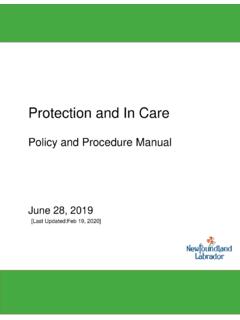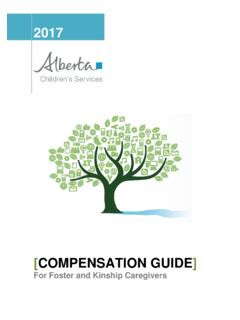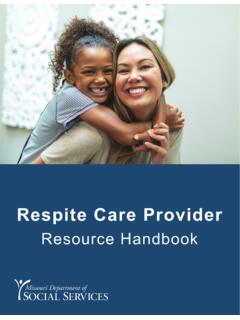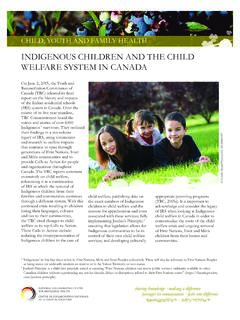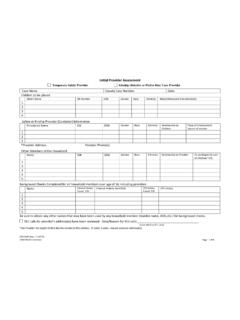Transcription of Kinship Caregivers and the Child Welfare System
1 Children s Bureau/ACYF/ | Email: | FOR FAMILIESMay 2016 Kinship Caregivers and the Child Welfare SystemWHAT S INSIDEK inship care and the Child Welfare systemHow the Child Welfare System becomes involved in Kinship careInvolvement of the courts Different types of Kinship careWhat to expect from the Child Welfare systemServices and how to access themPermanent families for childrenConclusionResources and links to more informationA number of grandparents and other relatives care for children whose own parents are unable to care for them. Sometimes, the arrangement (referred to as Kinship care ) is an informal, private arrangement between the parents and relative Caregivers . In some cases, guardianship is given to relative Caregivers and Child Welfare is not involved; in other situations, the local Child Welfare agency is involved. This factsheet is designed to help Kinship Caregivers including grandparents, aunts and uncles, other relatives, and family friends caring for children work effectively with the Child Welfare System .
2 Resources, such as links to more detailed information or places to find help, are 2a016htpsa:pt 1 wpe2 This material may be freely reproduced and distributed. However, when doing so, please credit Child Welfare Information Gateway. This publication is available online at care and the Child Welfare SystemChild Welfare systems vary from State to State, but they generally include public agencies such as departments of social services or family and children s services. These State or county agencies often work with private Child Welfare agencies to provide services for families and children. Caseworkers at these agencies are required by law to ensure the safety, well-being, and permanent living arrangements of children. Their responsibilities include investigating reports of Child abuse and neglect and arranging for services for children and families. Child Welfare agencies strive to provide services and resources to keep children in their homes with their families whenever possible.
3 Services might include parent education or counseling for mental health concerns; resources might include concrete help with Child care or housing. Child Welfare workers help parents build protective factors such as parental resilience, knowledge of parenting, and social connections that will ensure the safety of their Read about all the protective factors in Making Meaningful Connections: 2015 Prevention Resource Guide at When children cannot remain safely with their parents, placement with relatives is preferred over placement in foster care with nonrelatives. Caseworkers try to identify and locate a relative or relatives who can safely care for the children while parents receive services to help them address the issues that brought the children to the attention of Child Welfare . Placement with relatives or Kinship care provides permanency for children and helps them maintain family the Child Welfare System Becomes Involved in Kinship CareThe involvement of the Child Welfare System in Kinship care varies from State to State since each State has its own laws and practices that govern these situations.
4 It also varies from case to case, depending on the children s age, safety needs, legal custody, and other differences. If American Indian or Alaska Native children are involved, the Federal Indian Child Welfare Act must be The Indian Child Welfare Act (ICWA), 95-608, states that Tribes have the right to be involved in the Child Welfare and placement of Tribal children. For more information, visit the Bureau of Indian Affairs website at Child Welfare caseworker may initially approach a grandparent or other relative about becoming a Kinship care provider. In other situations, a family may contact the local Child Welfare agency for help. Some examples of these two types of contact are discussed Child Welfare Agency Makes the ContactThe local Child Welfare agency can initiate the contact to place children with Kinship Caregivers under a number of circumstances, as discussed on page 5.
5 However, in any of these circumstances, if no relatives can be located who are willing to take the children, they may come into the legal custody of the State and may be placed into nonrelative foster report of Child abuse or neglect is made. Child protective services screen reports of Child abuse and neglect according to State policies and practices. If investigators believe that children are in danger in their own home, they may be removed. Agencies are required to exercise due diligence in finding and notifying all grandparents and other adult relatives within 30 days after children are removed. Caseworkers often ask a relative to care for children until the case goes to court. If the case goes to court and charges are proven, the court and Child Welfare agency may select relatives to care for the children until a parent can safely care for them, or an alternative placement may be are arrested.
6 Police may arrest a parent or parents, but be willing to leave the children with a relative. The police then notify the Child Welfare agency of this temporary placement. Depending on the State laws and practice, the agency may leave the children with the relatives, take them into the State s legal custody and place them into nonrelative foster care , or take them into State custody but place them with the 2a016htpsa:pt 1 wpe3 This material may be freely reproduced and distributed. However, when doing so, please credit Child Welfare Information Gateway. This publication is available online at die. In the event that the custodial parent or both parents die, the Child Welfare agency may be responsible for locating relatives with whom the children can live. Parents or Other Family Members Make the ContactIn some situations, it is the parents, grandparents, or other relatives who contact the Child Welfare agency about the parent leaves the children with grandparents or other relatives and does not return.
7 Abandonment by a parent, even if it is temporary, may prompt Kinship Caregivers to call Child Welfare services and ask for help. In these situations, caseworkers may be able to offer services or help the kin to seek temporary legal custody through the court. However, if the parent remains missing and the kin cannot continue to care for the children, the children may be taken into the State s legal custody and placed in another or other kin are no longer able to care for children under an informal arrangement. In these situations, the Kinship caregiver may have planned to care for the children for a long time without agency help, but an unexpected circumstance forces the caregiver to seek help from the Child Welfare agency. For instance, the caregiver may become ill, a Child may suddenly need special services, or the caregiver may lose a job and no longer be able to support the children financially.
8 Child Welfare workers may be able to provide services for the Kinship caregiver or other placements for the voluntarily give up custody due to their own illness. Parents suffering from mental health concerns or from a debilitating illness, such as HIV/AIDS, may contact the Child Welfare agency and ask the agency for help. In such situations, caseworkers may seek out relatives with whom the children can be placed, rather than placing them with nonrelative foster parents. Many States have standby guardianship laws to address the needs of parents with debilitating or terminal illnesses. For more information on these State laws, see Information Gateway s Standby Guardianship at Parents no longer want a Child or children to live with them. In these situations, parents may turn over custody to the Child Welfare agency. This is more common when children are teenagers. If Child Welfare agencies take custody in these situations, the Child Welfare workers may look for relatives with whom the children can live.
9 Involvement of the CourtsKinship Caregivers who are part of the foster care System are likely to have some involvement with the court in most States, this occurs in a family or juvenile A full description of how the court process works in Child Welfare cases can be found in The Court Experience in Section 5 of McCarthy et al. A Family s Guide to the Child Welfare System at In cases in which the children have been removed from their parents because a parent has been accused of Child abuse, neglect, or abandonment, the following steps may happen:1. Child protective services investigators investigate the report of Child abuse, neglect, or abandonment usually by visiting the home and interviewing family If the investigators find enough evidence, they may decide to remove the children from their home for their own safety. The children may be placed with relatives, who then have physical There is a preliminary hearing (sometimes called an emergency removal or a shelter care hearing) before a judge.
10 The court determines whether to temporarily allow the children to be placed elsewhere, such as with the Kinship caregiver, until the trial. 4. At the trial (also called the adjudicatory hearing ), the judge decides whether there is enough evidence to prove that Child abuse, neglect, or abandonment occurred. 2a016htpsa:pt 1 wpe4 This material may be freely reproduced and distributed. However, when doing so, please credit Child Welfare Information Gateway. This publication is available online at If the judge decides that the Child or children should be removed from the parents, even temporarily, a dispositional hearing may also take place at this time. At this hearing, the judge determines where the children will live for the time being and who will have legal custody of them. 6. At least every 6 months after that, there will be review hearings before the judge to determine how the parents are progressing with their service plan (for treatment, parenting classes, or other requirements), how the children are doing in the home of their Kinship caregiver, and whether the service plan or goals for the children should be In addition to the review hearings, a permanency hearing is held 12 to 14 months after a Child is removed from the home and every 12 months after that.










